During the stalemate of the Great War, both sides took to the laboratory to try and get an edge on the battlefield and level the massive attack/defence discrepancy in their favour.
To this end each side ended up using to varying degrees: tanks, poison gas, aerial bombardment, advanced artillery spotting, mining, aerial reconnaissance, indirect machine gun fire, mortars… the list is pretty endless.
One area that was somewhat neglected in spite of its potential was small arms development. Repeating, smokeless rifles were still a relatively new thing, and commanders expected to make use of them in a similar way to the way they were used in the colonies. Blocks of men firing into an attacking force while the attacking force tried to get close enough to shoot back. Unfortunately this idea was put paid to by the enemy having very similar ballistic capabilities and ability to hit targets at quite the same ranges.

Although massed rifle fire at range did play something of a part in the early days of the war, especially at Mons and in the defence of Paris when both sides ground to a halt and entrenchment began volley fire became almost useless.

Of course in defence soldiers would line up on the parapet and shoot those missed by the machine guns but once the enemy was in the trench, your rifle that could shoot accurately somewhat further than you could see with the naked eye was only useful when you spun it round and used it as a club.

What soldiers needed was something with a high rate of fire that could deal with the high number of targets at close quarters experienced in trench conditions that didn’t necessarily have the range of a full rifle cartridge and certainly didn’t come with the weight of a typical machine gun of the era.
There were ready-made options. DWM already produced a carbine Luger with the infamous ‘trommel’ magazine for the German Army and a shorter Luger that could be fitted with a stock for the Navy.

Mauser produced the C96 for both the Austrians and the Germans and was used internationally. This frankly was much better with a stock used as a carbine than as a pistol.
Mannlicher had designed a carbine that, although it looks very C96-esque, operates differently and used a very early form of intermediate cartridge. These were never produced in large numbers and as far as I know never saw service anywhere.
For some reason, the Imperial Army decided to introduce a new firearm instead. There are a few plausible reasons for this, the Luger series and C96 pistols fired at extremely fast rates. Though this could be fixed (especially for the C96) they decided a new design would be cheaper and easier to achieve a desirable result with.*
Thus the MP18/I was born. This is the first dedicated infantry sub-machine gun, though some will cite other early SMGs, the MP18 was the only one widely used and issued in WWI, anything else used at this point really only featured as a footnote in the fighting.

It saw extensive use in the Spring Offensive of 1918, where the Germans took huge (in WWI terms) swathes of territory, exhausting their country’s war effort in the process.
Post-war, MP18s saw use in the Weimar Republic, especially in urban fighting between the German State, Freikorps and the German Red Army during various uprisings in Munich, Berlin, the Ruhr, Saxony and Hamburg. There was a good deal of rebellion and fighting, especially in the inner cities in between various political factions. During this time, the MP18 saw extensive use, showing a distinct superiority over conventional rifles and pistols in close quarter urban fighting.

Around the same time, these submachineguns saw use in South America, China and the Spanish Civil War. These things really got about.
During the early Weimar Republic, MP18s underwent some improvements: the Government took existing MP18s and modified the magazine wells to take stick magazines rather than Luger magazines and drums. During this later service they were issued with 20, 30 and 50 round magazines. There were also many licensed and unlicensed versions produced, with SIG and Haenel (under Schmeisser) each producing their own versions. Haenel developed it into the MP28 which the Spanish copied, having converted it to 9mm Largo.
There are dozens of descendants of the MP18, the most significant are the MP34, MP28, Sten and the Lanchester. These and their relatives were used internationally all through the late 20th century.

Although the open bolt submachine gun has fallen out of popular use with militaries and police forces, due to so many being produced you will still find descendants of the MP18 still in service in some parts of the world.
Notes:
*This said, the Imperial Army did experiment with a form of the C96 with detachable 40 round magazines. Few were produced, very few survive today.
Identification notes:
MP18/I: Slanted magazine well, takes Luger magazines (standard and Trommel). Two-option non-adjustable rear sight. Hooked Op handle

MP18 (type two): An MP18 in all respects except that the magazine well has been changed out to take a straight magazine. These should also have ‘1920’ stamped on the magazine well and on the receiver.
MP28/II: An MP18 but with perpendicular magazine well, box magazines and either the MP18 or a straight, tapered op handle with a ball end. Adjustable tangent rear sight.

Mitraillette 34: An MP28 made in Belgium. Cannot find pictures but expect Belgian markings and proofs.
Sig Bergmann 1920: Rounded Op handle, with bead on end. Collar at front of barrel shroud. Tangent rear sight. perpendicular mag well. Stick magazines.

Tsing Tao: Chinese characters, vertical magazine well. It looks like they also produced direct copies of the MP28.
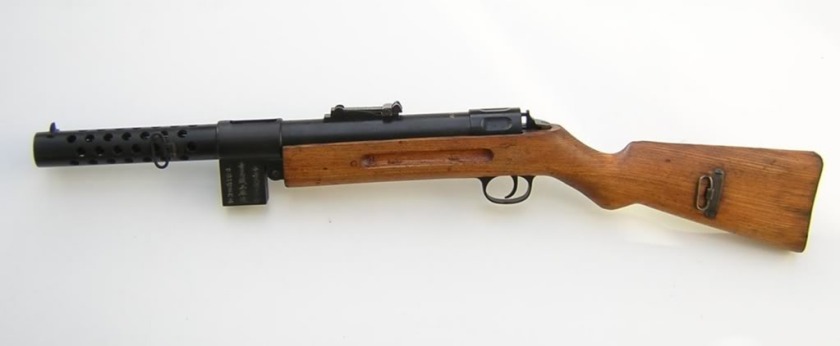
MP34: straight sides, magwell angled around the circumference of the receiver. Vented foresight guards. Bayonet lug on side. Adjustable rear tangent sight. Hinge behind magazine well to lift top cover. Unusual as has magazine charger at 90 degrees built into the mag well.

Lanchester MkI: Brass magazine well (though if still finished this may not be visible). 50 round magazine. Hooked op handle. Vented front sight guards. Tangent rear sight. Bayonet lug for SMLE P07 bayonet. Stock similar in shape to a P14 Enfield.

Lanchester MkI*: As MkI but straight op handle, fixed rear sight with two very large sight guards.

Bergmann MP35. You can take a look at the picture to ID this oddity.

The majority of decedents from beyond this point (Stens, Sterlings etc…) are for another article really. This is a rough guide, due to their extensive re-use and circulation there will be variants on variants I am quite sure. I have tried to give you the best chance of identifying different models, sometimes using original and sometimes applying my own nomenclature to differentiate between models. If you see anything that you can prove is incorrect with quality sources, please do get in touch on enquiries.vintageairsoft@gmail.com.
If this content interests you, subscribe to the blog or join us on Facebook for more! Don’t forget you can buy several of our ready-made products on Etsy.


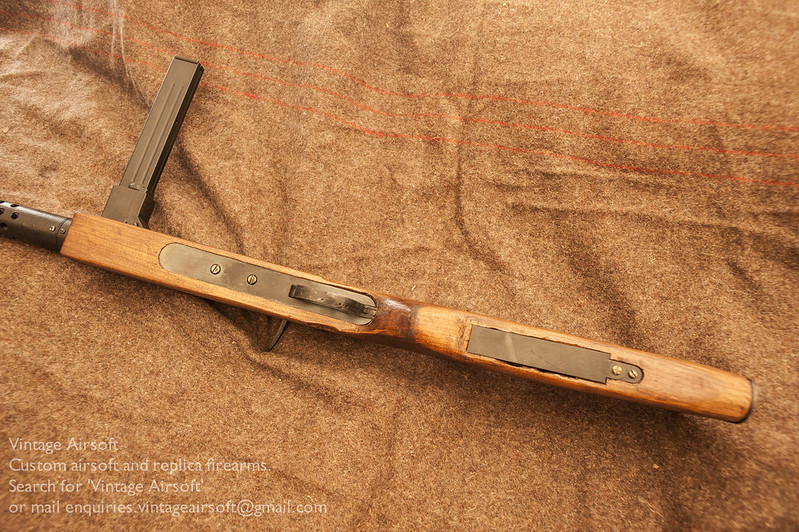

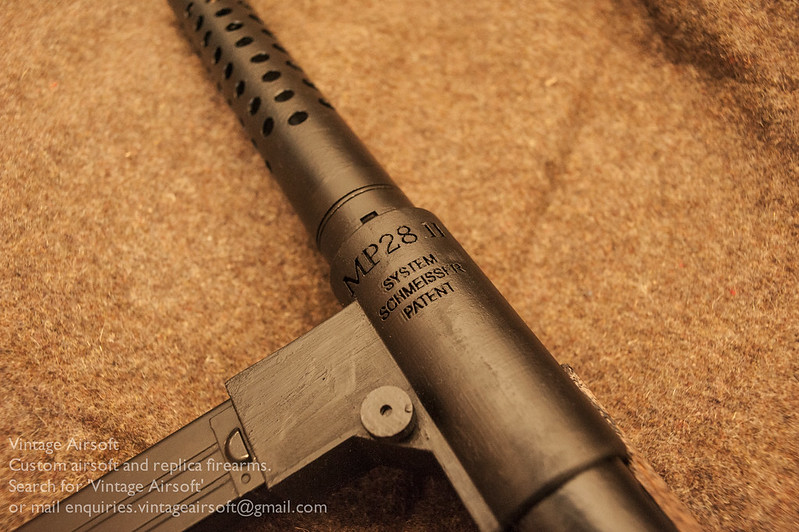
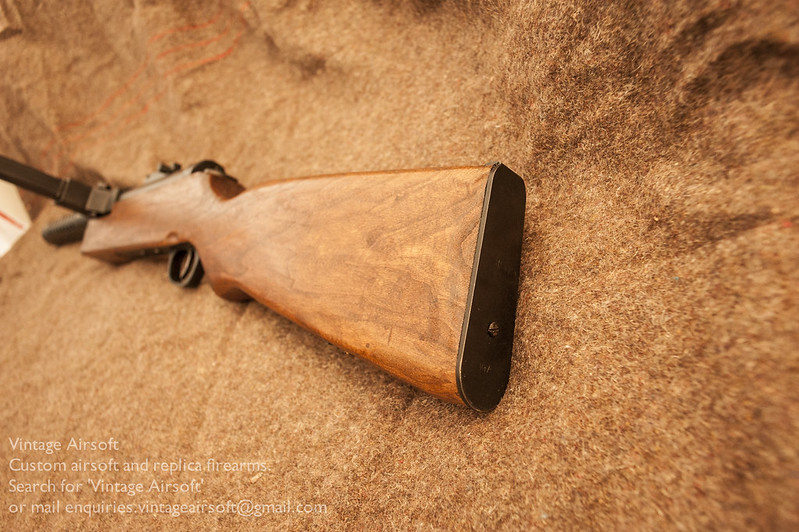





















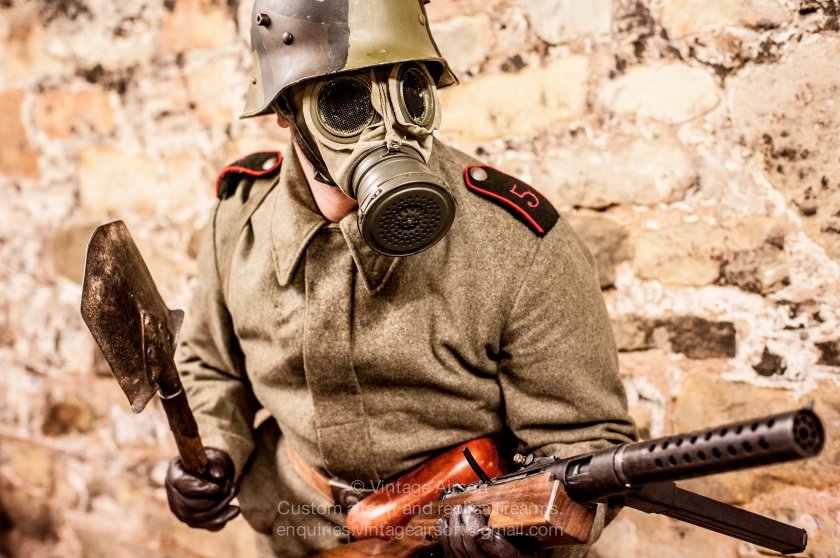



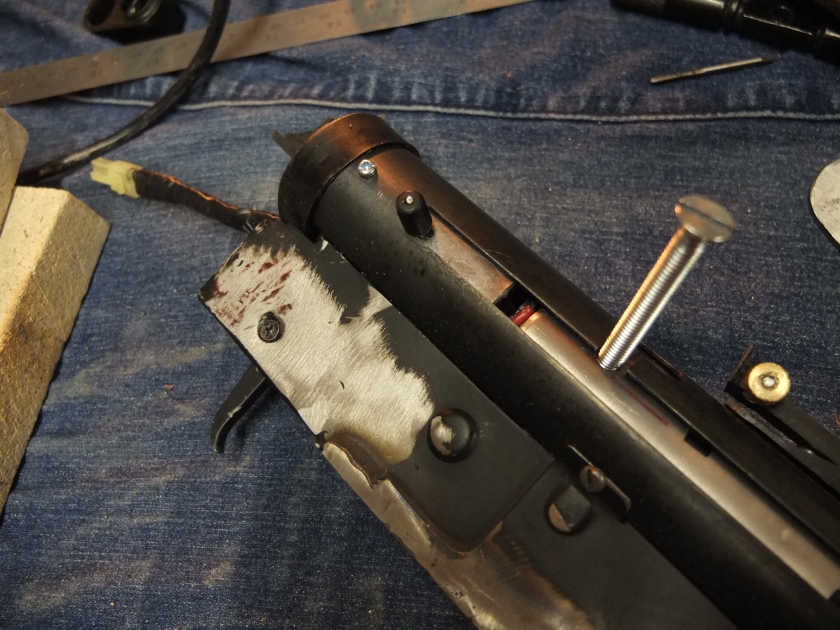





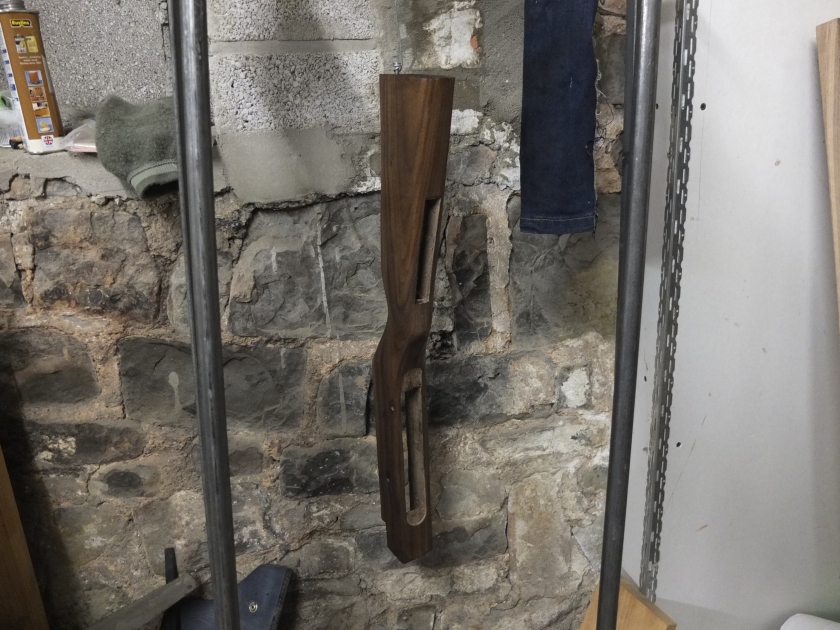
















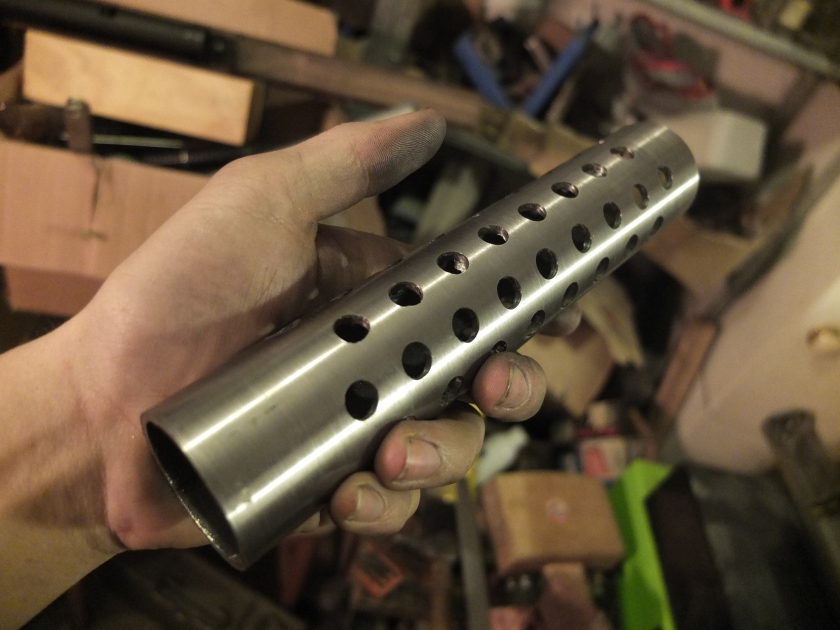

























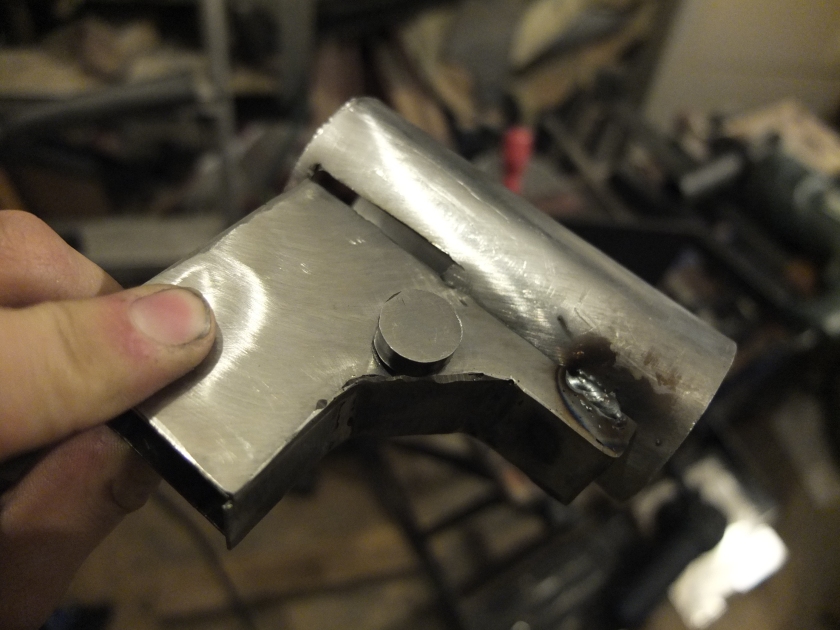





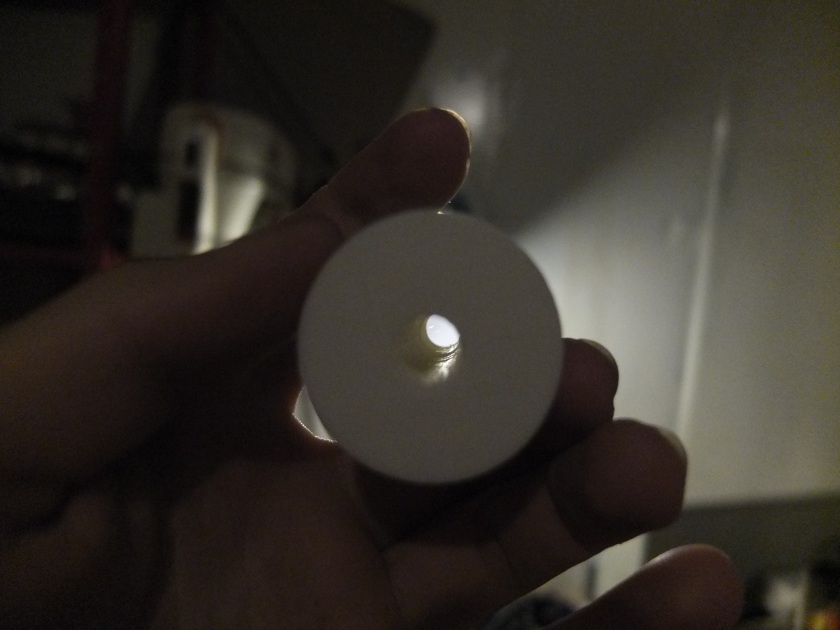


 The outer barrel is a piece of tube sat in the centre of the cooling jacket. Welded at the front and back are two steel rings to suspend the tube and at the front is the perforated front cap.
The outer barrel is a piece of tube sat in the centre of the cooling jacket. Welded at the front and back are two steel rings to suspend the tube and at the front is the perforated front cap.


 The rear sight functions much like the original, it is basically a miniaturised version of the sight I put on the MG08/15 with a ramp providing elevation adjustment and the leaf moving left and right for windage.
The rear sight functions much like the original, it is basically a miniaturised version of the sight I put on the MG08/15 with a ramp providing elevation adjustment and the leaf moving left and right for windage.
 Also to save space I have conducted a little modification to the gearbox externals. The motor cage in most V7 gearboxes is angled down slightly to fit in M14 models. This is great if you are building a rifle, not so much for this project!
Also to save space I have conducted a little modification to the gearbox externals. The motor cage in most V7 gearboxes is angled down slightly to fit in M14 models. This is great if you are building a rifle, not so much for this project!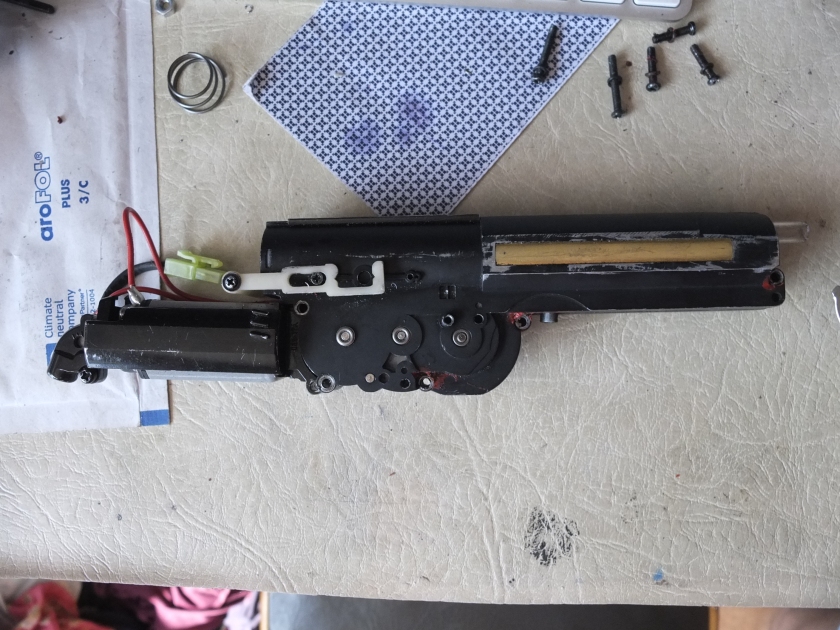 My first thought was to build a whole custom motor cage but this would be a huge job. Instead I modified the original cage so that it sits slightly angled up. The motor came into contact with the back of the spring casing before it could be secured so a little material had to be removed from there. As you can see from the photo above, the trigger and a part of the fire select has also been removed.
My first thought was to build a whole custom motor cage but this would be a huge job. Instead I modified the original cage so that it sits slightly angled up. The motor came into contact with the back of the spring casing before it could be secured so a little material had to be removed from there. As you can see from the photo above, the trigger and a part of the fire select has also been removed.




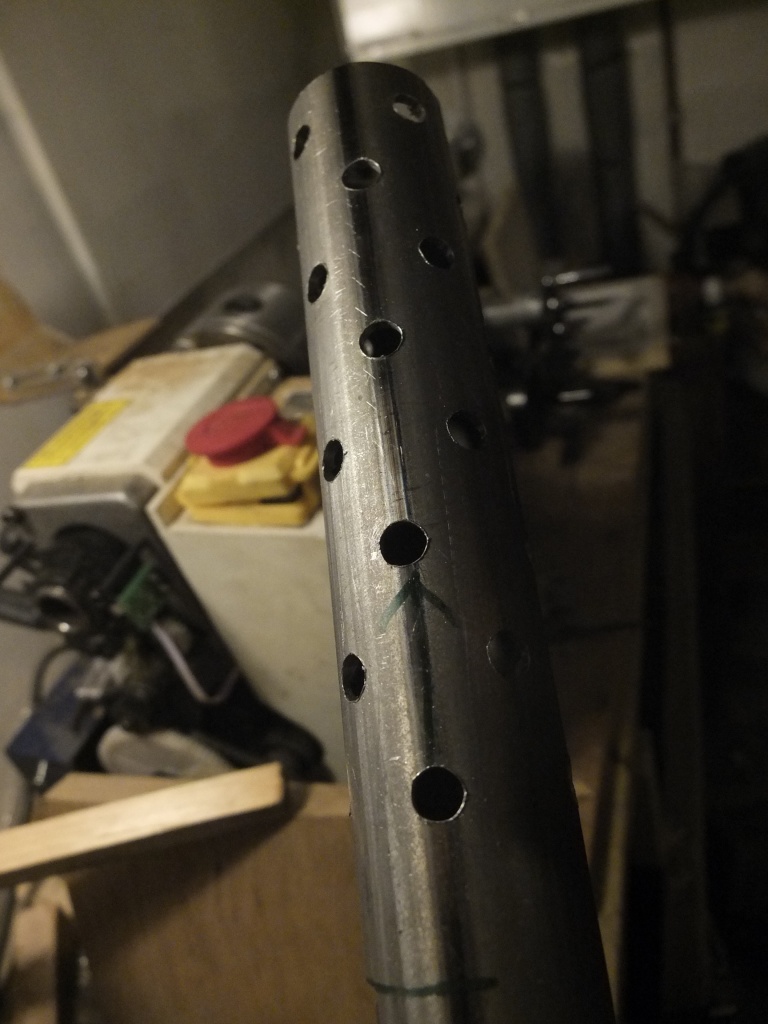
 A bit of work on the stock next. Having marked out the template on the wood, I cut the straight lines with a circular saw. The more complex area around the pistol grip I cut freehand with the router. This did however leave me with a little excess wood still holding the whole unit together.
A bit of work on the stock next. Having marked out the template on the wood, I cut the straight lines with a circular saw. The more complex area around the pistol grip I cut freehand with the router. This did however leave me with a little excess wood still holding the whole unit together.

 Finally, where the stock is at now. I’ve inhaled most of the wood removed today so it’s time to take a break! A bit more work with the mini sander and this will be as smooth as a baby’s bottom. That will have to wait until the action is fitted though as it is likely to sustain some bumps by then.
Finally, where the stock is at now. I’ve inhaled most of the wood removed today so it’s time to take a break! A bit more work with the mini sander and this will be as smooth as a baby’s bottom. That will have to wait until the action is fitted though as it is likely to sustain some bumps by then.

